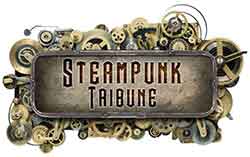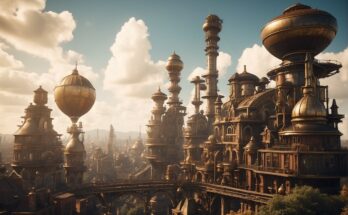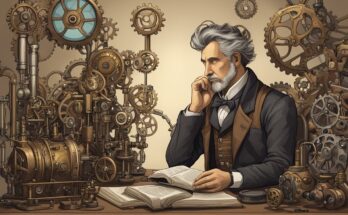Although there are a good number of Victorian scientists who fit the mold of a Steampunk inventor, Nikola Tesla could be considered the pattern from which the atypical scientist is derived…![]()
Best Known portrait of Nikola Tesla
Nikola Tesla
Age 38, 62″, 140 lbs. A tall, slender man, with a neatly trimmed thin mustache, intense gray-blue eyes, and black hair, dressed in a stylish suit and derby hat. He speaks English precisely, with only a slight accent.
Advantages: Ambidexterity, Attractive, Cool (under pressure), Eidetic Memory, Filthy rich, Less sleep, Lightning Calculator, Mathematical Ability, Strong Will, Versatile
Disadvantages: Compulsive Generosity, Loner, Obsession (Control himself and nature) , Phobia (Germs), Proud
Quirks: Dislikes June bugs and pearls (believes they drain life); Fascinated by cut gemstones; Calculates the volume of his food; Likes Pigeons; Likes the number 3
The above is the not-too-legendary version of Nikola Tesla early in 1895.
![]() Reading a book under a “Tesla Coil”Biography
Reading a book under a “Tesla Coil”Biography
Nikola Tesla was born in the village of Smiljan, then part of the Austro-Hungarian Empire, at midnight between July9 and 10, 1856. Though a sickly child, he grew into a vigorous and very intelligent young man. By the time he emigrated to the United States at 28, he was probably one of the worlds greatest inventors, but no one knew it yet. He had not published or patented the ideas that he carried in his head.![]()
Composite imagery of Tesla and his inventionsTeslas first year in America was difficult. He was hired by Thomas Edison, but soon quit. (Edison was dedicated to DC power and did not want to hear about Teslas AC system; the last straw was a disagreement over a bonus that Tesla thought Edison had promised). He worked as an engineer in a start-up company, but was soon pushed out by its investors. From spring of 1886 until 1887, he was reduced to working as a manual laborer. His luck finally changed in 1887, when he was backed by new investors. Within six months, he patented AC power dynamos, transformers, distribution systems, and motors. Soon afterwards, the patents were sold to George Westinghouse for a million dollars, plus royalties that would have totaled over 12 million dollars, but to help win the “battle of the currents”, he later gave those up.
![]() Colorized publicity photo supporting Alternating Current
Colorized publicity photo supporting Alternating CurrentFor the next seven years, Tesla was the toast of New York and the world as he made one amazing invention after another. He lectured in America and Europe, giving demonstrations that mystified both the public and scientists. At times, he seemed more like a flamboyant stage magician than a scientist. Invitations to his lavish parties followed by demonstration of his research were much sought after.
![]() Holding “balls of flame” in his hands
Holding “balls of flame” in his hands
Disaster struck on March 13, 1895: a fire swept through his uninsured laboratory, where all the money from his patents had been invested. Afterwards, he had to work with a more limited budget, mostly from donations. Despite this, he continued to show off new inventions and advance ideas for grandiose projects. But all his efforts did not produce any patents that businessmen were interested in buying.
![]() Wardenclyffe Tower (built for broadcast energy experiments)
Wardenclyffe Tower (built for broadcast energy experiments)
From 1903 on, it became increasing difficult for him to get loans or investments in his brainchild, broadcast energy. Over the previous eight years, he had spent $400,000 on experiments and had virtually nothing to show for it. His reputation declined, eclipsed by other inventors and smeared by rivals. He became a recluse, ignored by society, all but forgotten when he died in 1943. His last success came after his death, when the Supreme Court ruled that he, not Marconi, was the inventor of radio.
![]() David Bowie as Nikola Tesla Encountered
David Bowie as Nikola Tesla EncounteredTesla was one of the most ingenious men who ever lived, but he could also seem quite insane. His obsession with control caused him to reject emotion and try to be a perfect rational scientist. Though he rejected companionship, he loved the worship of admirers, though he might be unflustered by lab accidents or weird events, he had a streak of drama. Appeals to his pride could induce him to show off his lab or talk to people, especially rich, famous, or obviously intelligent ones.
![]() Image from the Nikola Tesla Museum
Image from the Nikola Tesla Museum
Telsa could be encountered anywhere, but he spend most of his time in his labs, first on South 5th Avenue just a few blocks away from Edisons New York headquarters, later on the Lower East Side of New York, near Colorado Springs, and on Long Island. He lived almost his whole adult life in hotels, starting out with the luxurious Waldorf-Asotria and declining to the New Yorker by the time of his death. For as long as he could afford it, he dined every night at Delmonicos Restaurant, but never with anyone unless he was throwing a party.Infante, V. (1999) – Gurps Who’s Who I, pg. 110-111, SJG:Austin[edited for removal of game specific content]
Further ReadingCheney, Margret: Tesla: Man out of Time
ONeill, John J.: Prodigal Genius: The Life of Nikola Tesla
Peat, F. David: In Search of Nikola Tesla
http://www.tesla.org/http://www.frank.germano.com/nikolatesla.htm
http://en.wikipedia.org/wiki/Nikola_Teslahttp://www.angelfire.com/tv/sarahlegend/tesla.htmlAn just in case you wish to try your hand at his inventions
http://amasci.com/tesla/tesla.html
Reading a book under a “Tesla Coil”Biography



